Turnkey Exhibit Rentals Include Transportation and Labor
Perfect for once-a-year trade shows and significant product roll-outs
Ownership requires variable recurring costs that often increase quickly and for unexpected reasons.
We provide fixed-cost published itemized pricing on over 40 customizable designs. View some of the Designs we love here.
Avoid high initial purchase costs.
The average 20×20 Double Deck purchase cost is nearly $85,000 or more. Increased steel and labor costs have had a big impact on fabrication. Freight and storage costs can easily total $15,000 a year. Show schedules are much tighter than they used to be, so set up is often at 25% straight time, an average of $150 hr to $250 hr. or more for double time. That’s per person with an average two-day setup with four people. After 3-5 years, when you’re ready for a new look, your exhibit is worth pennies on the dollar.
Turnkey Service that includes labor removes variables and increasing recurring costs.
One single pre-show invoice includes the exhibit, graphics, transportation, labor, and a hefty chunk of show services management. The ME2020 design is our popular 20 ft. TurnKey Double Deck at $38,211 plus graphics. The LC1010 V1 has two offset backlit mural panels for an eye-catching, custom look! View our line of 20 ft. backlit exhibits here on our sister website! These costs include transportation to and from the show, set up, and dismantling labor. The maximum cost for our largest Double Deck is about $250,000.
 Costs include graphics. We provide easy-to-understand graphics callout spec sheets and pre-production proofs for your approval. Once your design is finalized, we will provide a photorealistic rendering showing your graphics! We utilize several graphic materials, each ideally suited to the required application.
Costs include graphics. We provide easy-to-understand graphics callout spec sheets and pre-production proofs for your approval. Once your design is finalized, we will provide a photorealistic rendering showing your graphics! We utilize several graphic materials, each ideally suited to the required application.
Fixed Cost Set Up, dismantle, and freight.
Ultimately, you receive discounted labor because that cost is established during the quoting process, even though trade show mandated set-up hours, which may or may not be at straight-time hourly rates. This area is one of the largest sources of cost overruns.
What to expect managing a double deck exhibit – Lots of time and money
The cost of the time required of your staff when you manage your exhibit includes doing tasks that require lots of experience. As well, organizing the process is time-consuming. Exhibit Houses typically handle these things, but you pay to engage a large staff over a long period.
Double Decks often require 4 person set up / $800 hr! When we have arrived at the final design that works best for you, you’ll know the exact dollar cost well before the show. We can intuitively understand your situation; whether you are a novice or a veteran in the trade show industry, we collaborate as if we are your own Trade Show Marketing Department.
Your trade show marketing department – only when you need it
We specialize in renting Double Decks in Las Vegas and other areas. It’s what we do. TurnKey Service means just that. We start with the design process and establish your desired look and functionality. Generally, you’ll know exactly what your total cost will be at that point. There are no surprises!
We bill transportation and set up and dismantle labor on one pre-show invoice. However, we assist in several ways during the production process. We anticipate electrical requirements based on everything in your booth space during the design process. Some clients have specialized equipment or pre-existing exhibit properties to be combined in the same booth space.
We’ll provide a grid map with dimensions indicating your main electric drop and outlet locations throughout your booth space. We indicate how many amps are required in all areas. This is a very important show requirement! Nothing starts until the electric is down before the carpet is laid.
Part of that includes a booth orientation diagram that allows everyone involved to determine which direction is front by indicating adjacent booth space numbers. Often, this is dealt with early on because booth location often affects the design. Again, because we do this all the time, reviewing the Exhibitor Guide and viewing the trade show floor map is usually required early on.
Learn More About Why Renting a Double Deck In Las Vegas Provides So Many Cost Benefits
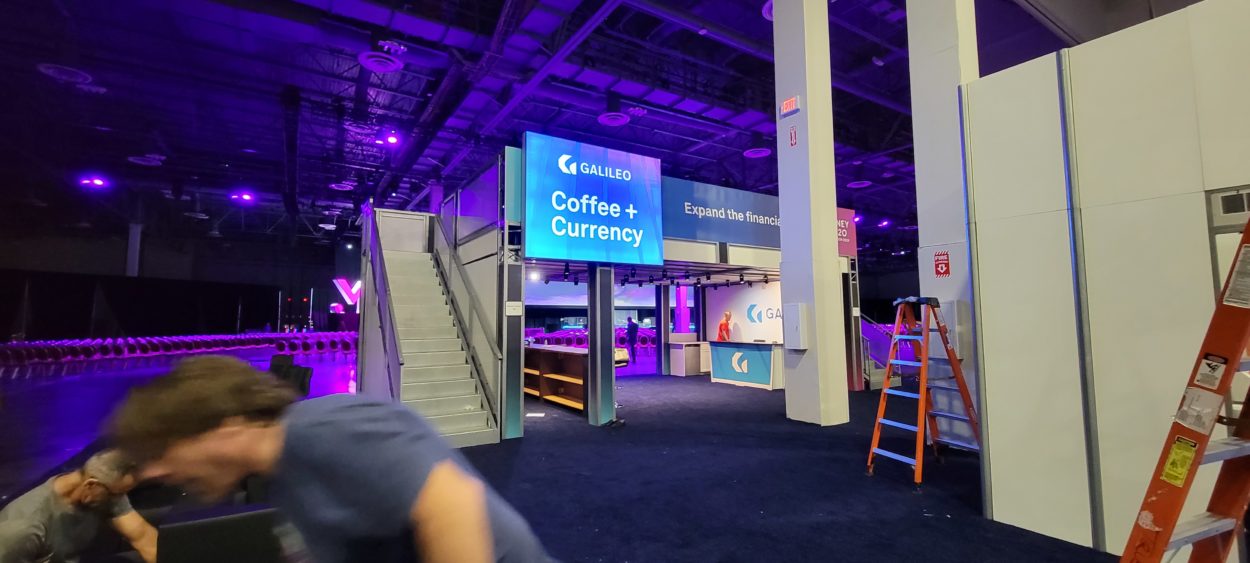 Back to the basics
Back to the basics
In addition to managing the process for each show, evaluating the cost of renting vs. ownership includes many factors. Key among them is storage and pre-show staging setup at an exhibit house. Generally, your exhibit is set up and taken down four times per show. After that, most exhibit houses bill for pre-show and post-show set-up at their facility to assess repair damages and ensure no surprises at the next show. It’s like setting up and dismantling labor three times for each show. So storage and management between shows can cost a lot of money you save when renting.
When exhibitors use show labor, the required forms precisely specify set-up and dismantle times. We look at your target move-in date and establish that for you. We need to do that to ensure that your exhibit is complete and ready to go on the deadline. This touches on another cost many clients don’t need to consider—overtime vs. Straight time Union Labor billing. We provide a fixed cost invoice for set up and dismantling regardless of the show-mandated schedule. This is one of the most common areas of cost overruns. Labor rates are often over $200 per hour. Overtime is time and a half, making it $300 hr.. Sometimes it can go to $200 hr. Multiply that x 3-4 set-up people; it can easily be over $500 hr. You don’t need to worry about that when working with TurnKey Trade Show Exhibit Rentals. Labor cost is fixed on one pre-show invoice.
Show Services and Show Regulations at Las Vegas Trade Shows
Many details must be considered to make your company’s Las Vegas tradeshow successful. The Las Vegas Convention Center has strict regulations to ensure the safety of attendees on the show floor. New exhibitors are encouraged to review the Exhibitor Services Manual carefully for current rules and regulations. Trying to make sense of these many regulations can be daunting, but Image Design & Communications is here to help. Our knowledgeable staff can help you navigate these pitfalls and ensure your trade show exhibit goes off without a hitch. Our turnkey show-ready exhibit rentals make it easy for you. Still, if you choose to set up your own display, some of the more important rules to consider when planning to exhibit at a Las Vegas convention are regulations that govern booth labor, freight, rigging, and the set up of electrical equipment and lighting.
Union Labor
The Las Vegas Teamsters union (Local # 631) has exclusive jurisdiction over the erection, dismantling, and repairs of all exhibits unless a full-time employee of the exhibiting company performs the work. Company personnel must carry company identification such as a business card or payroll stub. Freight handling is also under union jurisdiction, and teamsters are responsible for freight handling, including loading and unloading trucks and handling all machinery. An exhibitor may “hand carry” trade show material if handling does not require equipment. When hand-carrying material, an exhibitor may not access the loading dock/freight areas.
The stagehands are responsible for all programmable lighting, audiovisual productions, and related rigging. They also install and remove suspended trusses that contain dimmable or programmable lighting, studio motion picture lighting, sound system projectors, video walls, special effects equipment, and laser lighting.
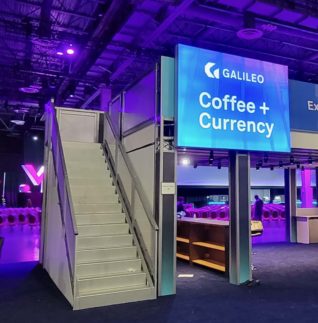 Planning Electric at Trade Shows
Planning Electric at Trade Shows
Electrical unions in Las Vegas are responsible for all work on any areas of a trade show booth that require electricity, including backlit headers, lightboxes, clip-on lights, plasma screens, or other AV equipment. Suspended light trusses and ground-supported trusses intended to distribute overhead electrical equipment are also under the jurisdiction of the electrician’s union. An electrical union representative must install hanging signs requiring electricity and teamster-assembled signs weighing over 300 lbs (Las Vegas Convention Center) or over 200 lbs (Sands Exposition). A general contractor may install non-electrical hanging signs under the weight restriction but are often abandoned after the show. It is advisable to have an exhibitor employee supervise any hanging sign work to ensure the sign is repackaged at the close of the convention.
An exhibitor may plug their equipment into the one 20amp/120 VAC receptacle provided for each booth and have up to four small clip-on lights per booth. Specifically, at the Las Vegas Convention Center, there is a ban on certain types of halogen lamps. Halogen lamps must not be over 75 watts and need to be of the sealed variety. Suspended light trusses and ground-supported trusses intended to distribute overhead electrical equipment are also under the jurisdiction of the electrician’s union, as well as all under-carpet wiring such as coaxial cable, fiber optics, and telephone.[/vc_column_text]
We provide the necessary EAC (Exhibitor Appointed Contract) forms and insurance certificates the show requires. This, along with accurate electric grid maps, relates to the fundamentals. If you need assistance with other show forms, we can help.
Space and height limitations. Double-deck exhibits usually require a minimum footprint of 20 by 20 feet and a 20-foot clear height, the vertical distance from the floor to the lowest underside point of the venue ceiling. Plus, most shows have maximum height restrictions based on booth size. For example, frequently, in-line booth space will have a maximum height restriction of 8 feet, and booths around the perimeter of the show hall are sometimes limited to 12 feet in height. Island and peninsula booths will also have height restrictions, usually between 16- to 30-foot maximums.
Weight capacity is a basic structural and safety concern your double deck must meet. You must ensure the structure can handle the load you intend to accommodate. For example, do you plan to host ten people in an upper-level conference room at a time, or might there be as many as 30 people on that upper deck at once?
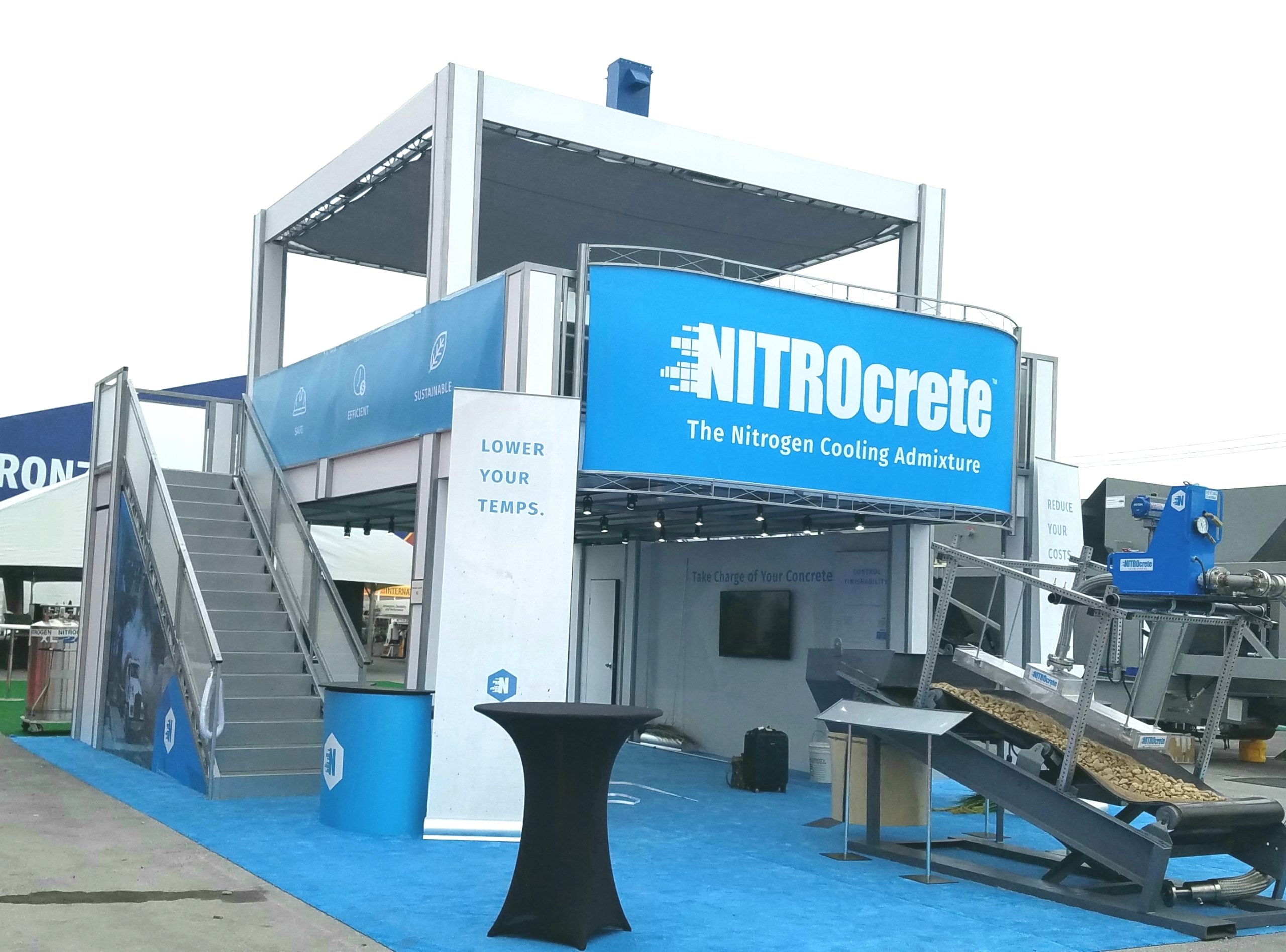 The engineering requirement for these structures is that they must withstand 100 to 125 pounds per square foot. While most systems easily meet this requirement, you’ll want to ensure that your double-deck provider understands the maximum number of people you intend to house on that upper level – and that the system is built to accommodate that load capacity.
The engineering requirement for these structures is that they must withstand 100 to 125 pounds per square foot. While most systems easily meet this requirement, you’ll want to ensure that your double-deck provider understands the maximum number of people you intend to house on that upper level – and that the system is built to accommodate that load capacity.
The number of stairways required is another capacity-specific figure. You’ll usually need two stairways if you plan to have 10 people or more on the deck at one time, and some show halls require you to install a second staircase for any double decks that are 300 square feet or more.
Any double-deck structure has several safety and stability requirements. The key to meeting them is maintaining an open dialogue with the engineers constructing your system and ensuring they fully understand how you plan to use your structure.
The fire marshal reserves the right to do a flame test on any exposed surface on the show floor. Since no industry standard exists for double decks, exhibitors must investigate the double-deck regulations for each show they attend. It’s always in your best interest to develop a broad understanding of what is required.
Local building and fire codes require that double-deck systems meet or exceed the standard for all temporary structures. Each state and often each city and/or county has its own rules, to the point that some states require state-specific structural engineering stamps, and others mandate that exhibitors hire a 24-hour fire-watch official to stand in the exhibit.
Again, your exhibit provider must be held accountable for adhering to these codes. However, the exhibitor manual generally doesn’t include all of the local requirements. It’s your provider’s job to seek out local codes and regulations with each venue, county, city, and state in which you plan to exhibit.
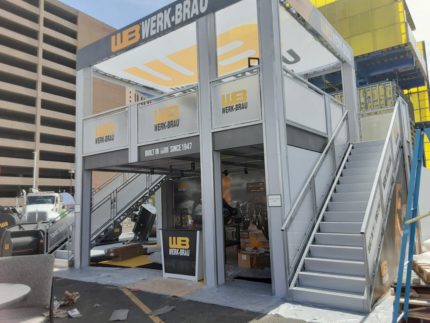 Double-deck structures may require fire-suppression systems and/or smoke detectors and fire extinguishers. These requirements are based primarily on size. In many cities, any design larger than 1,000 square feet will require a sprinkler system. However, in some cities, such as Las Vegas, you can bypass this rule with a fire break (i.e., a bridge structure between double-deck sections) – thereby eliminating the need for sprinklers. This bridge concept works excellently for huge decks of more than 1,000 square feet, allowing you to design the segments so no contiguous unit is more than 1,000 square feet. And you cannot cover the top of a second story, as water from the venue sprinklers needs to reach the whole structure.
Double-deck structures may require fire-suppression systems and/or smoke detectors and fire extinguishers. These requirements are based primarily on size. In many cities, any design larger than 1,000 square feet will require a sprinkler system. However, in some cities, such as Las Vegas, you can bypass this rule with a fire break (i.e., a bridge structure between double-deck sections) – thereby eliminating the need for sprinklers. This bridge concept works excellently for huge decks of more than 1,000 square feet, allowing you to design the segments so no contiguous unit is more than 1,000 square feet. And you cannot cover the top of a second story, as water from the venue sprinklers needs to reach the whole structure.
While double-deck structures have numerous stipulations, a reputable provider can help you avoid any associated issues. After all, a double deck is doubly effective for attracting attention and using vertical space in your booth.
Exhibit ownership is still the status quo, with 89 percent of exhibitors owning at least one structure and nearly a quarter of respondents holding five or more. On average, those exhibits are roughly four years old and travel to somewhere between five and ten trade shows per year. But with an average expected lifespan of about five years, many are ready for a bit of refurb. Almost six in 10 exhibit managers have refurbished an exhibit in the past, ranging from minor refurbs, such as updating graphics or exhibit elements, to major refurbs, like completely reskinning or reconfiguring an old booth. Regardless of the extent of those efforts, exhibitors found them worth the investment, with the majority extending the life of their structures by approximately one to four years.
For rental exhibits, three-quarters of marketers understand their benefits, but only about one-fifth have taken advantage of rental options in the past 12 months. Most renters prioritize criteria such as design, customization options, and price over floor plans, payment options, or vendor reputation when shopping for a rental. And while custom-rental options are a relatively new phenomenon in the industry, a near-majority are familiar with the heightened customization and lower upfront investment they afford exhibitors. At the same time, nearly one-third have considered custom rentals for their programs.
A trusted partner
Image Design and Communications, Inc. is a relationship-based company. During the process, we get to know you and understand your needs. We establish a relationship. That’s why our tagline reads “Building Relationships Through Design.”
Trade Show Exhibit Rentals in Las Vegas is one of the best-kept secrets in the industry!
Visit DoubleDeckExhibitRentals.com, which provides detailed specs and published itemized pricing! How do we do it? Over the years, we’ve assembled partners across the country who specialize in Booth I & D Labor, trade show freight, regional warehousing and specialized graphics production. By working together in a coordinated fashion, we can provide  excellent service at a competitive price. Our two trade show exhibit rental websites offer vast options with eye-catching graphics to draw your best prospects to you. TurnKey pricing means your Transportation and Labor costs are included in our published prices. We’ll work with you to find the best solution to your trade show marketing needs!
excellent service at a competitive price. Our two trade show exhibit rental websites offer vast options with eye-catching graphics to draw your best prospects to you. TurnKey pricing means your Transportation and Labor costs are included in our published prices. We’ll work with you to find the best solution to your trade show marketing needs!
The Image Design Double Deck Difference”
Buying or Renting a Turnkey Two Story Custom Exhibit from Image Design means that your transportation, set up, and dismantle costs are fixed. Regardless of whether the show has your set up / tear down scheduled for a partial time and half overtime or weekend double time, you have the peace of mind of knowing that you’ll stay within budget. Essentially, you’ll walk onto the trade show floor with your exhibit set up and waiting to go to work for you. When the show is over, your graphics are protected safely in our shipping crates and returned to our warehouse, ready to go for your next show.
Las Vegas specialists in Custom Double Deck and In-Line Exhibits
The ability to arrive at the show floor set up and ready to go and walk away when the show is done is both cost-saving and convenient. You receive premium service at a competitive, more than reasonable cost. For more information on large island exhibits up to 70′ x 100′, visit: DoubleDeckExhibitRentals.com.
We use state-of-the-art engineering in our Double Deck structures, reducing weight and enabling a more efficient setup and tear-down process. We are certified for all Convention Centers across the US. Standard features include 9′ ceilings with built-in track lighting on the lower level, frosted acrylic upper deck and stair railing, and a choice of column and header accent panels.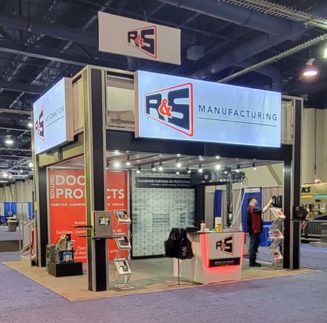
Assistance with Show Services paperwork
Additional Show Services costs billed by the show include Material Handling, Rigging, and Electric. We will estimate what the show will charge to bring your exhibit from the loading dock to your booth space. The cost is generally $75 per 100 lbs, with the average 10′ exhibit being 400 lbs, and our ME2020 Double Deck weighs in at 5,550 lbs ($300- $4,000). Our floor-level carpet and Installation cost is $4.75 ft., generally the same or less than the official trade show cost. (Upper deck carpeting is included in our pricing).
Regarding the sale and rental of trade show Double Deck Exhibits and smaller display rentals, Image Design is your best resource for exceptional trade show marketing success!
Renting a customized double-deck exhibit has never been so easy AND cost-effective!
We’ve assembled an impressive array of well-designed custom trade show double decks. No one offers you more design options with clear itemization and costs so you can make informed decisions about what works best for your company. View the variation designs available using the links provided when you see a design you like. Enjoy exceptional value for trade shows in Los Angeles and Las Vegas. Other cities generally incur a 5% – 10% out-of-venue fee. We offer several unique custom exhibit options, including laminate finishes, slat walls, and product shelves, as well as large, seamless, high-resolution printed fabric murals for spectacular trade show graphics.
Las Vegas, Orlando, Chicago, and Los Angeles(as well as other cities) have specific regulations and certifications for using a double deck booth at tradeshows. Our stock designs are pre-approved for use in all major venues, and custom designs are always left with stamped engineering drawings. But you don’t have to worry about that! We take care of all insurance and regulatory documents for you. Its all part of the turn key experience we provide. With rentals, we, as the exhibit house, hold the responsibility for abiding by every stipulation for the structure, the venue, the show, and even the city, state, and county in which the show is held in regards to delivery, install/dismantle, and the structural integrity and certification of the booth.
for using a double deck booth at tradeshows. Our stock designs are pre-approved for use in all major venues, and custom designs are always left with stamped engineering drawings. But you don’t have to worry about that! We take care of all insurance and regulatory documents for you. Its all part of the turn key experience we provide. With rentals, we, as the exhibit house, hold the responsibility for abiding by every stipulation for the structure, the venue, the show, and even the city, state, and county in which the show is held in regards to delivery, install/dismantle, and the structural integrity and certification of the booth.
Common Restrictions and requirements at most trade shows.
Not all cities or venues have the same requirements, so check your show manual beforehand. We will help you find the information and review it with you to ensure everyone understands the show clearly.
1. Space and height limitations. Double-deck exhibits usually require a minimum footprint of 20-by-20 feet and a 20-foot clear height (the vertical distance from the floor to the lowest underside point of the venue ceiling). Plus, most shows have maximum height restrictions based on booth size. For example, an in-line booth space will often have a maximum height restriction of 8 feet, and booths around the perimeter of the show hall are sometimes limited to 12 feet in height. Island and peninsula booths will also have height restrictions, usually between 16- to 30-foot maximums.
So, before you purchase a double deck, examine the floor plans and venue heights of the shows you typically exhibit at. The ceiling levels of some venues are too low even to house a double-deck structure. Plus, since ceiling heights can vary within a venue (Houston and Las Vegas venues are famous for this), the ceiling height restrictions for individual booth spaces can vary dramatically at the same show.
2. Structural safety and stability. Your double deck must meet weight capacity, a basic structural and safety concern. You must ensure the structure can handle the load you intend to accommodate. For example, do you plan to host 10 people in an upper-level conference room at a time, or might there be as many as 30 people on that upper deck at once?
A typical engineering requirement for these structures is that they must withstand 100 to 125 pounds per square foot. While most systems easily meet this requirement, you’ll want to ensure that your double-deck provider understands the maximum number of people you intend to house on that upper level – and that the system is built to accommodate that load capacity.
The number of stairways required is another capacity-specific figure. You’ll usually need two stairways if you plan to have 10 people or more on the deck at one time, and some show halls require you to install a second staircase for any double decks that are 300 square feet or more.
Any double-deck structure has several safety and stability requirements. The key to meeting them is maintaining an open dialogue with the engineers constructing your system and ensuring they fully understand how you plan to use your structure.
3. Show regulations. Many shows welcome the use of double-deck exhibits, but for safety and liability concerns, they include several restrictions for them. For example, in San Francisco and several cities in the Pacific Northwest, the deck has to meet local earthquake codes. In San Diego and Los Angeles, the fire marshal reserves the right to do a flame test to any exposed surface on the show floor (which means he or she can hold a flame to the material, and it must not combust within a 30-second exposure). In Orlando, FL, show authorities sometimes go so far as to measure railing gaps and guardrail heights during setup to ensure that your construction matches the submitted drawings.
Since no industry standard exists for double decks, exhibitors (or their suppliers) must investigate the double-deck regulations for each show they attend. Again, if you have a reliable double-deck provider, it’ll do this legwork for you. But it’s always in your best interest to develop a broad understanding of what is required. Some of the more common show-regulation stipulations you’ll run into are mandatory guard-rail heights of 42 inches, a stair-width minimum of 3 feet, and the placement of fire extinguishers and smoke detectors in specified locations.
4. Local-area regulations. In most locales, such as Clark County, NV (Las Vegas), Orange County, FL (Orlando), and Cook County, IL (Chicago), local building and fire codes require that double-deck systems meet or exceed the standard for all temporary structures. Each state and often each city and/or county has its own rules, to the point that some states require state-specific structural engineering stamps, and others mandate that exhibitors hire a 24-hour fire-watch official to stand in the exhibit.
Again, your exhibit provider 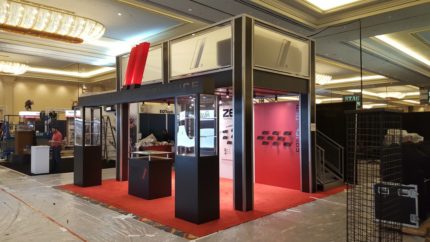 should be held accountable for adhering to these codes. However, the exhibitor manual generally doesn’t include all of the local requirements. It’s your provider’s job to seek out local codes and regulations with each venue, county, city, and state in which you plan to exhibit.
should be held accountable for adhering to these codes. However, the exhibitor manual generally doesn’t include all of the local requirements. It’s your provider’s job to seek out local codes and regulations with each venue, county, city, and state in which you plan to exhibit.
5. Fire safety/ADA requirements. Double-deck structures may require fire-suppression systems and/or smoke detectors and fire extinguishers. These requirements are based mostly on size. In many cities, any structure larger than 1,000 square feet will require a sprinkler system. However, in some cities, such as Las Vegas, you can bypass this rule with a fire break (i.e., a bridge structure between double-deck sections) – thereby eliminating the need for sprinklers. This bridge concept works great for large decks of more than 1,000 square feet, allowing you to design the segments so no contiguous unit is more than 1,000 square feet. And you cannot cover the top of a second story, as water from the venue sprinklers needs to reach the whole structure.
In addition, the Americans with Disabilities Act (ADA) is often a concern for double decks, as there is very little written about trade show-related mandates. If you want to err on the side of caution, then consider an upper deck a public environment. In this case, you should either a) offer ramps or elevators to the second level or b) ensure that whatever is offered or available on the second floor is also available on the first floor.
While numerous stipulations involve double-deck structures, a reputable provider can help you sidestep any associated issues. After all, a double deck is doubly effective when it comes to attracting attention and using the vertical space in your booth.
Additional Show Services costs billed by the show include Material Handling, Rigging, and Electric. We will estimate what the show will charge to bring your exhibit from the loading dock to your booth space. The cost is generally $75 per 100 lbs, with the average 10′ exhibit being 400 lbs and our ME2020 Double Deck weighing in at 5,550 lbs ($300- $4,000). Our floor-level carpet and Installation cost is $4.75 ft., generally the same or less than the official trade show cost. (Upper deck carpeting is included in our pricing).
